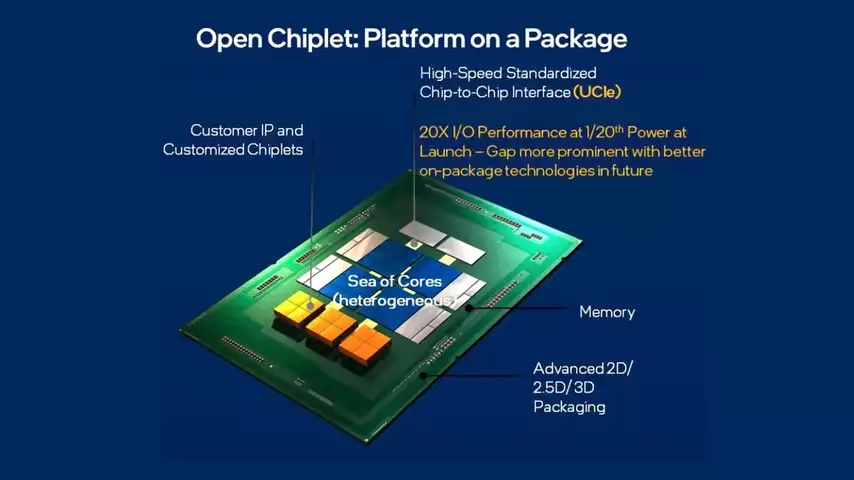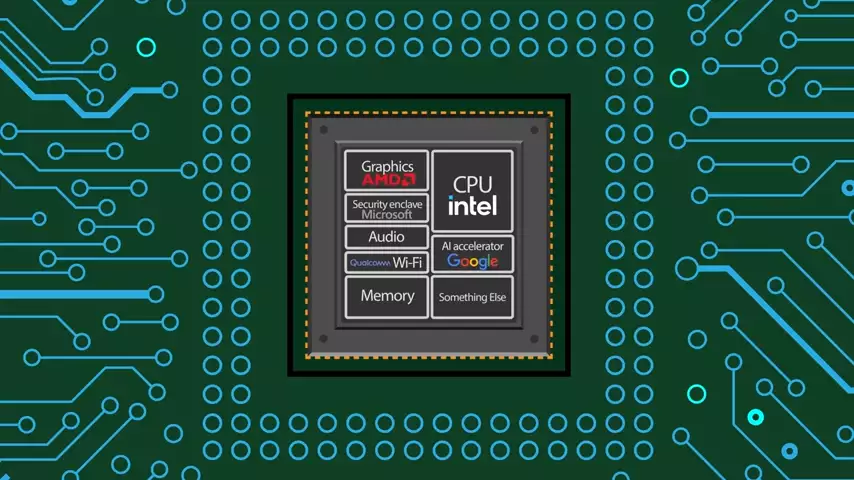Imagine you could build a CPU in much the same way that we build PCs today with parts from different manufacturers. This might actually become a reality in the near future, thanks to a new standard called the UCIe that's being pushed by a lot of major players in the tech industry
UCIe stands for Universal Chiplet Interconnect Express, and it sounds a bit like PCI Express, right? Funnily enough, it's conceptually similar. Instead of adding to your computer's functionality with cards that fit into slots, UCIe builds on a chip's functionality with additional chiplets.
Instead of adding to your computer's functionality with cards that fit into slots, UCIe builds on a chip's functionality with additional chiplets.
As an example, UCIe might allow for a system on chip that has an Intel CPU, graphics from AMD, and a Wi-Fi radio from Qualcomm, a security enclave from Microsoft, and an AI accelerator from Google.  We did see something like this in 2018 when Intel came out with those Kaby Lake G processors that featured AMD graphics. But UCIe takes this concept further and also standardizes it. That's the important part.
We did see something like this in 2018 when Intel came out with those Kaby Lake G processors that featured AMD graphics. But UCIe takes this concept further and also standardizes it. That's the important part.
But, hold on. Systems on a chip are already a thing, so what's the point of this modular approach? Well, most current SoCs are designed as a single monolithic chip, which presents some manufacturing disadvantages.
Read also: lga vs pga
You see, transistors have gotten much smaller, which makes our chips perform better and consume less power. But as we start hitting the limits of how small we can make them, the obvious way to continue improving performance is to make the chips bigger. But doing this raises the chances of a manufacturing defect, one little tiny defect, that will render the entire thing useless.  So instead of throwing the baby out with the bath water, the industry is moving towards smaller chiplets that can be combined after the manufacturer. Moreover, UCIe enables chiplets from different companies to be combined, another key difference from how chiplets are usually put together. You can even combine different chiplets that use different process nodes onto the same package.
So instead of throwing the baby out with the bath water, the industry is moving towards smaller chiplets that can be combined after the manufacturer. Moreover, UCIe enables chiplets from different companies to be combined, another key difference from how chiplets are usually put together. You can even combine different chiplets that use different process nodes onto the same package.
Believe it or not, wireless chips for things like Wi-Fi and 5G actually perform better with larger transistors because there isn't as much signal leakage. So you could combine a modem built on a larger node with a processor built on a smaller one.
This opens the floodgates for companies to make different kinds of specialized chips at relatively low-cost without having to design them from scratch. Meaning, it could be easier and cheaper in the end to get a phone with better AI for photo editing and voice transcription, for example, instead of like we have right now, where we are relying on the Apples of the world to make one chip to rule them all.
But how exactly does UCIe help chips from different companies talk to each other? How does the standard work?
Let's talk about how these chiplets would communicate. You know how we compared UCIe to PCIe earlier in the video? UCIe can actually use PCI Express to move data between chiplets, much the same way an NVIDIA graphics card can talk with an Intel CPU.
UCIe can also use another protocol called Compute Express Link or CXL, which is basically a higher performance PCIe variant for data centers. But because UCIe is designed primarily for chiplets that sit right next to each other, it's much lower latency than a typical PCI Express implementation, and it can also move plenty of data. We're talking 1.3 terabytes per second through one millimeter of chip edge.
That quick communication means that UCIe chips could combine features that would otherwise need to be on separate chips or even separate cards while using a lot less power. But it's not quite the same thing as AMD's Infinity Fabric or Apple's UltraFusion used in the M1 Ultra as directly connecting CPU cores, like those do, requires more complex designs. And keep in mind that UCIe is a very new standard. So don't expect to see tons of PCs, and phones, and servers that could be rocking it immediately. But it could end up being quite a big deal down the line as industry heavy hitters, like Intel, AMD, ARM, Google, Microsoft, Meta, Samsung, Qualcomm, and TSMC have all thrown their weight behind the standard. And keep an eye on Apple and NVIDIA.
Apple has moved toward designing their own ARM-based Silicon in house, while NVIDIA continues to favor monolithic chips. But maybe we'll see them jump on the UCIe train in the future if it does end up becoming a ubiquitous industry standard. In the meantime, I think I'll design my own phone chip with two 5G modems. So then it'll be 10G. That's not how it works? 25G!


No comments yet